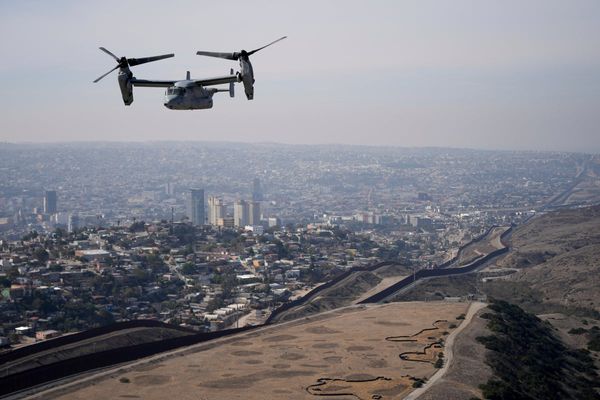
A week after Creative Australia controversially dumped artist Khaled Sabsabi as Australia’s representative for the 2026 Venice Biennale, Richard Bell still can’t understand the decision.
The Kamilaroi, Kooma, Jiman and Gurang Gurang artist has a long history with the Venice Biennale and Australia’s peak arts funding body – in 2019, he crashed the prestigious showcase after being passed over to officially represent Australia. He’s shocked that Creative Australia would allow itself to be blind-sided by criticism of Sabsabi’s past work, and its refusal to answer predictable attacks with a nuanced conversation.
“This could have all been avoided,” Bell says. “Creative Australia should have known that they would come after this work, and prepared the minister.
“They could just say, ‘Actually the work’s almost 20 years old, you’re supposed to be talking about the proposal to go to Venice next year, and this so-called “leader of the terrorist group” at the time, wasn’t listed as a terrorist group until 14 years later’.”
The furore began shortly after Sabsabi and curator Michael Dagostino’s selection was announced on 7 February, when Yoni Bashan, a columnist at The Australian, received a “flurry of messages”. Bashan’s background was in crime and business reporting, and last year was given the Sir Keith Murdoch award by his employer for his reporting of the conflict in Gaza, where he was embedded with the Israel Defense Forces.
According to The Australian’s daily news podcast, the tip-offs drew Bashan’s attention to the “really unusual decision” by Creative Australia to award the prestigious spot to Sabsabi. Sabsabi’s selection was the result of the same process that saw Archie Moore win the prestigious Gold Lion at last year’s biennale, but Bashan had little familiarity with Sabsabi or Creative Australia — which he has described on the podcast as “another obscure government agency amply funded with millions and millions of taxpayer funds”.
“I’m not an arts reporter, I write business gossip in The Australian. This is all a bit too flutey for me, this sort of stuff,” Bashan said on the podcast.
Bashan said that when he first investigated Sabsabi’s work, including a 2007 video work entitled You, he found it “a little bit ambiguous” whether the art was in support of Hassan Nasrallah, the now deceased leader of the terrorist group Hezbollah, or not.
It didn’t matter.
“I’m a journalist. I’m not an arts patron. Me as the writer, as the journo, it’s not for me to figure out or solve the mystery of what Khaled Sabsabi thinks about Hassan Nasrallah.”
As the starting point of a media and political storm that has upturned Australia’s art world, this incuriosity would become a defining theme. In the Senate last Thursday, Liberal senator Claire Chandler reduced Sabsabi, an artist with a complex, decades-long body of work, to “a person who highlights a terrorist leader in his artwork”.
Within hours, Sabsabi and Dagostino had been dropped by the board of Creative Australia.
Elizabeth Ann Macgregor, who headed Sydney’s Museum of Contemporary Art (MCA) at the time it acquired You, says the debate has ignored the original context and impact of his work.
“You cannot judge a work of art by a few images online I’m afraid, that’s the nature of art,” Macgregor told the ABC this week.
“Once people have the opportunity in a gallery to see the work in its full context and indeed to see other works by the same artist … they very rarely jump down your throat about it.”
You was displayed at the MCA for three months in the 2009 exhibition Making it New: Focus on contemporary Australian art, where between 8 September and 11 November a total of 61,276 people visited the exhibition.
Those 61,276 people could have read the accompanying panel, which drew attention to the “purposefully ambiguous” depiction of the “spiritual and political leader”. Prophetically, the text explained that You was a comment on how media coverage can turn people into heroes or villains and “its ability to generate suspicion or panic through the intensive repetition of imagery on our television screens, day in and day out”.
Djon Mundine, Bundjalung artist, curator and recipient of the Australia Council’s Red Ochre lifetime achievement award in 2020, was first exposed to Sabsabi’s work over a decade ago while working at the Campbelltown Arts Centre, where You was on display in a group show with other artists from Western Sydney.
“I thought the artwork was actually a great piece of work, it was the first time I’d seen digitally manipulated imagery, really,” Mundine says.
The apparent “charisma” of Nasrallah’s portrayal was created in a time where positive representations of Lebanese people in Australia’s public sphere were rare, he added: “There wouldn’t have been a lot of Lebanese heroes you would have found in Sydney, not many teachers or artists.”
Like Bell, Mundine also notes that the wider Hezbollah organisation was not proscribed as a terrorist group by Australia until 2021 (the Australian government had, however, listed its External Security Organisation military wing as a terrorist organisation in 2003). Nasrallah was killed in September last year by an Israeli strike on southern Lebanon. His funeral is scheduled for 23 February.
But not every viewer agreed with Mundine’s interpretation. A piece published by online journal Memo on Thursday quoted Western Sydney University academic Cecelia Cmielewski, who viewed You as a critique of Nasrallah, interpreting the venerating light as “laser beams of hate”.
As the Memo article’s authors Rex Butler and Paris Lettau note, these layers of irony and ambiguity, and the time and thought required to interpret them, are essential to appreciating Sabsabi’s earlier work.
The MCA says that according to its records, compiled from visitor comment books and contemporaneous reports by gallery staff, there were no noted incidents or negative reactions while You was on display.
Mundine says the Campbelltown exhibition had a similar response. “It was never thought, from my memory, that it was dividing society at all – and see, that’s such a white-bread place too, Campbelltown,” Mundine says.
Speaking to Guardian Australia on Tuesday, Macgregor also commented on Thank You Very Much, a second video work by Sabsabi that Chandler characterised in parliament as “promoting Osama bin Laden and a series of 9/11 images of the aircraft hitting the twin towers”.
The 18-second-long Thank You Very Much consists of shaky, frenetically edited footage of the World Trade Center attacks, and concludes with footage of the then-US president, George W Bush, thanking the American public shortly after the attack. Within a few months, Bush had launched a series of military responses, from Afghanistan to Iraq, that would have a profound impact on members of the Arab diaspora around the western world, Sabsabi included.
“It’s a quote from George Bush, yes,” Macgregor said. “So it’s irony.”
“So when you read that, you know, you get a shiver – but that often is the point with art. You have an initial reaction, and then you have a chance to see it. And you often have a chance to be in a gallery, where there are people to talk about it.”
For Mundine, You became the start of a long relationship with Sabsabi, whose work has evolved to explore more conceptual and spiritual themes, and a diverse range of mediums including choirs and live performance.
“My conversations with him were about somebody who is into Sufism, and he has always been this quite peaceful person. But we also talked about football teams … he’s just a good bloke, that’s all.”
At the time, the work inspired no backlash in either the media or the art world.
“No one attacked him at the time, particularly, when he did that work – so why now?” Mundine says.
Mundine was thrilled to hear of Sabsabi and Dagostino’s selection and, like Bell, was shocked by Creative Australia’s “cowardly” reversal days later.
“It showed a very clumsy handling of the whole thing,” he said. “They should have been aware of some of this, that he’d be immediately attacked.”
Over at The Australian, the reluctant art critics who launched the attack on Sabsabi’s selection continue to show little interest in the complexities of his work. Reflecting on his depiction of Nasrallah, the column has since declared that, “if it walks like a duck, talks like a duck, then it’s probably outright hero worship.”
For Bell, the fact that a few words from two journalists was enough to make Creative Australia’s leadership abandon Sabsabi, Australia’s art community, and the complex nature of art itself, remains inexplicable.
“Virtually the whole of the art world, the Australian art world, they’ve rallied behind Khaled,” he says. “And yet that counts for nothing.”







